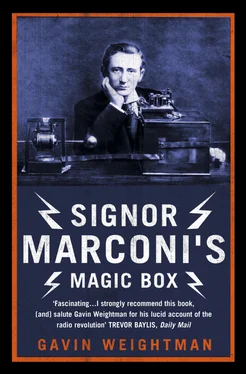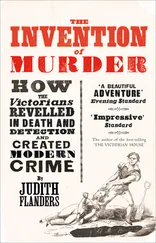Marconi replied: ‘I don’t know. I am not a professional scientist, but I doubt if any scientist can tell you.’ He thought it might have something to do with the form of the wave. As to the nuts and bolts of his equipment, Marconi said apologetically that he could not say more because it was being patented, and was therefore top secret. What he could tell the astonished reporter was that his waves ‘penetrate everything and are not reflected or refracted’ even by solid stone walls or metal. He could even send them through an ‘ironclad’, a heavily reinforced battleship.
This last claim set up instant alarm in the reporter: its implications were far more serious than the possibility of X-rays compromising the modesty of ladies. ‘Could you not from this room explode a box of gunpowder placed across the street in that house yonder?’ Dam asked.
‘Yes,’ Marconi replied confidently. ‘If I could put two wires or two plates in the powder, I could set up an induced current which would cause a spark and explode it.’
‘At what distance have you exploded gunpowder by means of electric waves?’
‘A mile and a half.’
Could Marconi’s instruments ignite the explosive magazine of an ironclad and blow it up from a distance? Already the Royal Navy was concerned that if its ships carried wireless telegraphy equipment, the signals might blow up their own stores of powder. It could be a problem, Marconi conceded. Beams from electric lighthouses along the coast could destroy an unwary fleet in seconds. Warming to this notion, Dam wrote: ‘Of all the coast defences ever dreamed of, the idea of exploding ironclads by electric waves from the shore and over distances equal to modern cannon ranges is certainly the most terrible possibility yet conceived.’
Blowing up ships, however, had never been in Marconi’s mind. Quite the reverse. From boyhood, when his father had bought him a yacht which he sailed in the Bay of Genoa, he had loved the sea. Though he had no clear idea how his wireless waves would be used in practical terms, he did imagine that there was a real prospect of communications between ships and shore, and between ships on the open ocean, where there were no telegraph cables.
In London, Marconi and his mother could have enjoyed a glamorous social round: nightly balls, dinner parties, the opera, Ascot and all the trappings of the Season. Annie had many relatives in town, and always enjoyed her trips to England. But there was to be little time for frivolous socialising: Guglielmo had succeeded beyond their wildest dreams, and he was fearful that if he did not move fast someone else would overtake him in the exploitation of the new telegraphy. After all, he was only an amateur whose invention was homespun, devised after long hours working alone in the attic of the family country home in Italy.
*In 1895 Professor Bose, of the Presidency College, Calcutta, had succeeded in ringing a bell and exploding a mine with electro-magnetic waves while working along the same lines as Marconi.
The Villa Griffone is set in its own grounds of orchards, vineyards and fields in rolling countryside outside the village of Pontecchio, near Bologna. Bologna had water-powered silk-weaving mills long before the Industrial Revolution transformed British industry in the late eighteenth century. The city had a distinguished history of scientific discovery, and was the home of the eighteenth-century pioneer of electrical forces Luigi Galvani. Nearly all the advances in the study of electro-magnetism had been achieved by trial and error, in the absence of any useful theory. In fact theory had sometimes got in the way of understanding, as is often the case. Galvani, a Professor of Anatomy at the ancient University of Bologna, had come to the conclusion that frogs could produce electricity after the chance discovery that specimens he was dissecting reacted to an electrical current. His disciple, and later his opponent, Alessandro Volta showed that the frogs were merely acting as crude batteries, and went on to create the first means of storing electricity which could be tapped for a continuous source of current. The work of both men has been commemorated in the terms ‘galvanised’ and ‘voltage’.
From an early age Guglielmo Marconi was familiar with Bologna’s scientific heritage, and in the long summer days at the Villa Griffone he began his first experiments with the mysterious forces of electricity. Marconi’s heritage – and the pioneer days of wireless – arose from a most unlikely union between Irish whiskey and Italian silkworms. That his mother and father should have met at all was remarkable, that they should have fallen in love even more so, and that they married in the teeth of opposition from her family the most unlikely event of all. Theirs was a story of high romance, yet precious little of it is known apart from the reminiscences of Marconi’s mother, recorded much later by her granddaughter Degna.
Annie Jameson was born in 1843, one of four daughters of Andrew Jameson of County Wexford in Ireland, the well-known and wealthy distiller of Jameson’s Irish whiskey. The family lived in an old manor called Daphne Castle, which had parkland and a moat. Annie had one outstanding talent: singing. As a teenager she had wanted to perform in opera, and according to the family legend had been invited to sing at the Royal Opera House in Covent Garden. Her father refused to let her go: the stage was not in those days regarded as a suitable place for well-bred young ladies. As compensation for the thwarting of her ambitions it was arranged that Annie should go to Bologna to study singing. There she could stay with business contacts of the Jamesons, a respectable Italian family called de Renolis, and could sing to her heart’s content without risk to her family’s reputation.
The de Renolis family had suffered a personal tragedy a few years before Annie arrived to stay with them. In 1855 their daughter Giulia had married a moderately prosperous landowner called Giuseppe Marconi. In the same year Giulia had given birth to her first child, a son, Luigi. Sadly, as happened so often at that time, the young mother survived the birth of her son by only a few months. Giuseppe, now a lone parent, remained close to the de Renolis family. He had moved to Bologna from the hill country of the Apennines, which run like a backbone through north central Italy. When his wife died he asked his father, who still lived in the mountain village where Giuseppe had been brought up, to join him in Bologna. The ageing Domenico Marconi agreed, sold up his mountain estate and moved to the city. But Bologna was too busy and confined for him, so he bought an estate at Pontecchio, eleven miles away. In the large, square, plain but handsome Villa Griffone he took to raising silkworms, and made some success of it, while his widower son Giuseppe husbanded the orchards and the fields in the rolling countryside.
When Annie Jameson came to stay with the Renolis she was introduced to their bereaved son-in-law and little grandson Luigi. Giuseppe lived more at the Villa Griffone than in Bologna, and Annie must have spent some time there too, for she fell in love with the place and with him. She returned to Ireland to ask her family for permission to marry her Italian sweetheart, but they flatly refused to consider it. According to her granddaughter Degna, the grounds for rejection were that he was much older than her (by about seventeen years), he already had a son, and to top it all he was a foreigner. Annie had to bow to the authority of her father, and appeared to accept the decision. But she kept in touch with Giuseppe, with letters somehow smuggled between Ireland and Italy, and vowed to run away to marry him when she reached the age of majority at twenty-one. This she did, meeting him in Boulogne-sur-Mer on the northern coast of France, where they married on 16 April 1864. As husband and wife they took stage coaches across France, over the Alps and back to Bologna and the Villa Griffone. Their first child, Alfonso, was born a year later. Nine years later, in April 1874, Annie gave birth in Bologna to a second son, Guglielmo. Both boys were baptised Roman Catholic, although their mother was Protestant.
Читать дальше












